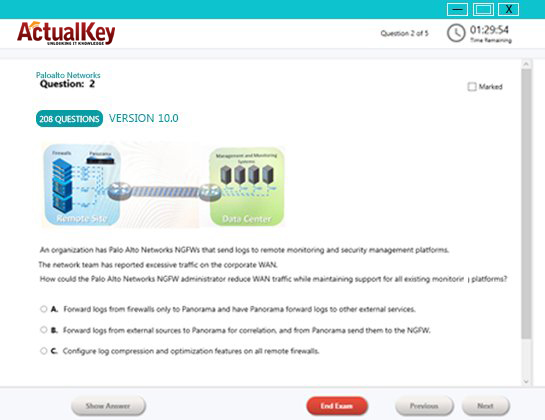Limited Time 30% Discount Offer Use Code - off30
Actualkey Prepration Latest 300-375 : Securing Cisco Wireless Enterprise Networks Questions and Answers PDF's, Verified Answers via Experts - Pass Your Exam For Sure and instant Downloads - "Money Back Guarantee".
| Vendor | Cisco |
| Certification | CCNP Wireless |
| Exam Code | 300-375 |
| Title | Securing Cisco Wireless Enterprise Networks |
| No Of Questions | 147 |
| Last Updated | January 19,2024 |
| Product Type | Q & A With Explanation - Version: 11.0 |
| Bundel Pack Included | PDF + Offline / Andriod Testing Engine and Simulator |
300-375 WISECURE
Securing Wireless Enterprise Networks
Exam Number 300-375
Associated Certifications CCNP Wireless
Duration 90 Minutes (60 - 70 questions)
Available Languages English
Register Pearson VUE
Exam Policies Read current policies and requirements
Exam Tutorial Review type of exam questions
This exam tests a candidate's knowledge of implementing client device security, identity based authentication and services, along with securing and monitoring the Enterprise wireless infrastructure.
The 300-375 Securing Wireless Enterprise Networks (WISECURE) exam is a 90-minute, 60-70 question assessment that is associated with the CCNP Wireless certification. This exam tests a candidate's knowledge of implementing client device security, identity based authentication and services, along with securing and monitoring the Enterprise wireless infrastructure. Candidates can prepare for this exam by taking the Securing Wireless Enterprise Networks (WISECURE) course.
The following topics are general guidelines for the content that is likely to be included on the exam. However, other related topics may also appear on any specific instance of the exam. To better reflect the contents of the exam and for clarity purposes, these guidelines may change at any time without notice.
1.0 Integrate Client Device Security 19%
1.1. Describe Extensible Authentication Protocol (EAP) authentication process
1.2. Configure client for secure EAP authentication
1.2.a. Native OS (iOS, Android, Windows, MAC OS, year 2013+) or AnyConnect client
1.3. Describe the impact of security configurations on application and client roaming
1.3.a. Key caching
1.3.b. 802.11r
1.4. Implement 802.11w Protected Management Frame (PMF) on the WLAN
1.4.a. Client support
1.4.b. PMF modes
1.4.c. Relevant timer settings
1.5. Implement Cisco Management Frame Protection (MFP)
1.5.a. Cisco Compatible Extensions (CCX)
1.5.b. Infrastructure mode
1.5.c. Client and infrastructure mode
1.6. Describe and configure client profiling
1.6.a. ISE
1.6.b. WLC
2.0 Implement Secure Distribution System Connectivity Services on the Wireless Infrastructure 24%
2.1. Describe the impact of BYOD on wireless security
2.1.a Additional security risks
2.1.b Loss of device control
2.1.c Increased complexity of policy enforcement
2.2. Implement BYOD policies
2.2.a. Single vs dual SSID
2.2.b.Self registration
2.2.c. mDNS sharing
2.2.d.Wi-Fi Direct
2.3. Implement AAA based Layer 3 security on the controller
2.3.a. Local Web Auth (LWA)
2.3.a.[i] External authentication)
2.3.a.[ii] Locally significant certificates
2.3.a.[iii] Pre-authentication ACL
2.3.a.[iv] Pass through configuration
2.4. Describe regulatory compliance considerations for protecting data and access and providing accountability
2.4.a. PCI
2.5. Utilize security audit tools for Distribution Systems
2.5.a. PI reports
2.5.b. PCI audit
3.0 Implement Secure Client Connectivity Services on the Wireless Infrastructure 27%
3.1. Implement 802.1x wireless client authentication
3.1.a. AireOS
3.1.a.[i] Local
3.1.a.[ii] Central
3.1.b. IOS-XE
3.1.c. Autonomous
3.1.c.[i] Local authentication
3.1.c.[ii] Remote authentication
3.1.d. FlexConnect
3.1.d.[i] Local authentication
3.1.d.[ii] Remote authentication
3.2. Implement Identity Based Networking (IBN)
3.2.a. AireOS
3.2.a.[i] VLANs
3.2.a.[ii] QoS
3.2.a.[iii] ACLs
3.2.b. IOS-XE
3.2.b.[i] VLANs
3.2.b.[ii] QoS
3.2.b.[iii] ACLs
3.2.c. Autonomous
3.2.c.[i] VLAN
3.2.d. FlexConnect
3.2.d.[i] VLAN
3.2.d.[ii] ACLs
3.2.d.[iii] QoS
3.3. Implement ISE AAA parameters for integration with the wireless network
3.3.a. Network device
3.3.b. IBN profile
3.4. Implement AAA based Layer 3 security using ISE
3.4.a. Utilizing ISE as AAA service
3.4.a.[i] Locally significant certificates on ISE
3.4.a.[ii] Using captive portal capabilities for guest access
3.4.b. Central Web Auth (CWA
3.4.b.[i] Returned values and overrides
3.4.b.[ii] Access accept
3.4.b.[iii] AAA override statement
3.5. Configure MSE based web authentication
3.6. Utilize security audit tools for client connectivity
3.6.a. PI reports
3.6.b. PCI audit
4.0 Implement Secure Management Access on the WLAN Infrastructure 14%
4.1. Controlling administrative access to the wireless infrastructure
4.1.a. RADIUS
4.1.b. TACACS
4.1.c. Controller and ISE integration
4.1.d. Access point administration credentials
4.2. Configure APs and switches for 802.1x access to the wired infrastructure
4.2.a. Controller based
4.2.b. Autonomous
4.3. Implement SNMPv3 on the wireless infrastructure
4.3.a. AireOS
4.3.b. IOS-XE
4.3.c. Autonomous
5.0 Monitoring Security on the WLAN Infrastructure 16%
5.1. Execute Security reports on PI
5.2. Perform Rogue Management
5.2.a. Rogue Containment on WLC and PI
5.2.b. RLDP on WLC and PI
5.2.c. SwitchPort tracing on PI
5.2.d. Location on PI
5.2.e. Rogue Rules on WLC and PI
5.3. Monitor rogue APs and clients
5.3.a. PI Maps
5.3.b. Controller
5.4. Monitor Alarms
5.4.a. 2 items
5.4.b. PI Security Tab
5.4.c. Controller Trap Logs
5.5. Identify RF related Security interferers on WLC and PI Maps
5.5.a. Jammers
5.5.b. Inverted Wi-Fi
5.5.c. Wi-Fi invalid channel
5.6. Implement wIPS
5.6.a. Enhanced Local Mode (ELM)
I Got My Success Due To Actualkey 300-375 Bundle Pack Actualkey experts I got passed in the 300-375 exam without any worries at all, these exam material products gave me the reason to relax.
Budi Saptarmat
Yahoo! Got Successfully Through The 300-375 Exam Passing Exam is not a easy thanks to Acutalkey.com for providing me actual 300-375 Securing Cisco Wireless Enterprise Networks training with there included the Offline and Android simulators helps me success
Melinda
300-375 Exam Best Preparation I have been preparing for 300-375 Securing Cisco Wireless Enterprise Networks, I was not sure that I'll be able to pass because of the fact that I am not a good student however;Actualkey.com provided me best and simple exam training pdf's and I passed. I now recommend everyone
Antonio Moreno
Actualkey.com 300-375 Offline Simulator is Best My choice to select Actualkey.com and go for the preparation 300-375 Securing Cisco Wireless Enterprise Networks, because I got the short way with the easy way
Liliane Meichner
Actualkey.com 300-375 Exam PDF"s passed with in a week 300-375 exam pdf's that's amazing
James Wilson
Cisco - RELATED EXAMS
Implementing Cisco Unified Communications Manager Part 2 (CIPT2 v6.0)
Questions: 174 | May 8, 2024
Implementing Cisco Security Monitoring, Analysis andResponse System
Questions: 49 | May 8, 2024
Cisco Wide Area Application Services for System Engineers exam
Questions: 60 | August 1, 2024
Cisco Data Center Networking Infrastructure Solutions design
Questions: 120 | August 1, 2024
Implementing Cisco Unified Wireless Networking Essentials (IUWNE)
Questions: 203 | July 1, 2024
Associated Certifications: Cisco Storage Networking Support Specialist
Questions: 74 | August 1, 2024
Implementing Cisco Security Monitoring, Analysis, and Response System
Questions: 67 | August 1, 2024
Wide Area Application Services for System Engineers (WAASSE)
Questions: 90 | January 5, 2024
Implementing Advanced Cisco Unified Wireless Security (IAUWS)
Questions: 85 | January 7, 2024
Troubleshooting and Maintaining Cisco IP Switched Networks (TSHOOT)
Questions: 72 | January 7, 2024
Implementing Cisco Unified Communications Voice over IP and QoS v8.0 (CVOICE v8.0)
Questions: 257 | July 1, 2024
Securing Networks with Cisco Routers and Switches (SECURE) v1.0
Questions: 136 | July 1, 2024
Implementing Cisco Unified CommunicationsManager, Part 2 v8.0 (CIPT2 v8.0)
Questions: 215 | July 1, 2024
Introducing Cisco Voice and Unified Communications Administration v8.0
Questions: 300 | May 8, 2024
Integrating Cisco Unified Communications Applications v8.0 (CAPPS v8.0)
Questions: 203 | May 8, 2024
Operational Foundations for Cisco Service Provider Core Networks
Questions: 91 | May 8, 2024
Maintaining Cisco Service Provider VPNs and MPLS Networks (MSPVM)
Questions: 89 | May 8, 2024
Cisco Data Center Unified Computing Support Specialist Qualifier Exam (DCUCI Qualifier Exam)
Questions: 65 | May 8, 2024
Cisco Data Center Unified Computing Design Specialist Qualifier Exam
Questions: 62 | May 8, 2024
Designing for Cisco Internetwork Solutions Exam (DESGN) v2.1
Questions: 241 | October 1, 2024
Maintaining Cisco Service Provider Routing Protocols (MSPRP)
Questions: 70 | October 1, 2024
Maintaining Cisco Service Provider Quality of Service (MSPQS)
Questions: 91 | October 1, 2024
PSACAS Advanced Collaboration Architecture Sales Specialist Exam
Questions: 56 | May 8, 2024
PSACASE Advanced Collaboration Architecture System Engineer Exam
Questions: 64 | May 8, 2024
PSACAFE Advanced Collaboration Architecture Field Engineer Exam
Questions: 50 | August 1, 2024
Cisco IronPort Certified Security Professional (CICSP) Web Security 7.0
Questions: 66 | August 1, 2024
Implementing Cisco TelePresence Video Networking Solutions Exam
Questions: 57 | August 1, 2024
Advanced Borderless Network Architecture Systems Engineer Exam
Questions: 60 | August 1, 2024
Cisco Substation Automation System and Field Engineer Knowledge Verification
Questions: 58 | May 8, 2024
Authorized Connected Grid Account Manager Knowledge Verification
Questions: 23 | August 1, 2024
Cisco Data Center Unified Computing Systems Implementation (DCUCI)
Questions: 78 | May 8, 2024
Introduction to 802.1X Operations for Cisco Security Professionals Exam (S802DT1X)
Questions: 69 | May 8, 2024
Introducing Cisco Identity Services Engine for System Engineer Exam (PAISESE)
Questions: 34 | May 8, 2024
PASCERAM - Cisco SaaS Conferencing and EIM Resale ATP for the AM Exam
Questions: 35 | May 8, 2024
Cisco SP Video Wireline & Cable Headend Design Specialist for SE
Questions: 33 | May 8, 2024
PASCERSE - Cisco SaaS Conferencing and EIM Resale ATP for the SE Exam
Questions: 56 | May 8, 2024
Building Cisco Service Provider Next-Generation Networks, Part 2
Questions: 126 | May 8, 2024
Building Cisco Service Provider Next-Generation Networks, Part 1 Exam
Questions: 257 | October 25, 2024
Implementing Advanced Cisco Unified Wireless Security (IAUWS) v2.0
Questions: 206 | May 8, 2024
Deploying Cisco Service Provider Network Routing (SPROUTE)
Questions: 174 | January 12, 2024
Implementing Cisco Service Provider Next-Generation Core Network Services (SPCORE)
Questions: 184 | January 12, 2024
Implementing Cisco Service Provider Next-Generation Edge Network Services (SPEDGE) Exam
Questions: 185 | January 12, 2024
Implementing and Maintaining Cisco Technologies Using IOS XR - (IMTXR)
Questions: 77 | January 12, 2024
Designing and Implementing Cisco Unified Communications on Unified Computing Systems - DIUCUCS
Questions: 60 | January 12, 2024
Implementing and Configuring Cisco Identity Service Engine - SISE
Questions: 49 | July 1, 2024
PASCERFE - Cisco SaaS Conferencing and EIM Resale ATP for the FE Exam
Questions: 53 | July 1, 2024
Advanced Borderless Network Architecture Field Engineer Exam
Questions: 86 | January 15, 2024
Advanced Borderless Network Architecture Systems Engineer Exam (700-303)
Questions: 156 | January 15, 2024
Cisco Implementing Cisco Secure Mobility Solutions Exam (SIMOS)
Questions: 543 | May 17, 2024
Unified Communications Contact Center Express Implementation - UCCX
Questions: 50 | January 15, 2024
Performing Business-Focused Transformative Architecture Engagements
Questions: 67 | January 17, 2024
Configuring Cisco UCS and Cisco Catalyst 3000 for Vblock Series 100
Questions: 45 | January 17, 2024
Cisco Application Centric Infrastructure for System Engineers
Questions: 58 | January 17, 2024
Implementing Cisco Service Provider Mobile Unlicensed Small Cell Solutions
Questions: 51 | January 17, 2024
Securing Cisco Networks with Sourcefire Intrusion Prevention System
Questions: 59 | January 17, 2024
Implementing Cisco Service Provider Mobility UMTS Networks (SPUMTS)
Questions: 70 | January 17, 2024
Implementing Cisco Service Provider Mobility CDMA Networks (SPCDMA)
Questions: 70 | January 17, 2024
Implementing Cisco Service Provider Mobility LTE Networks (SPLTE)
Questions: 70 | January 17, 2024
Integrating Business Applications with Network Programmability (NPIBA)
Questions: 66 | January 17, 2024
Managing Industrial Networks with Cisco Networking Technologies (IMINS)
Questions: 64 | January 17, 2024
Designing with Cisco Network Programmability for ACI (NPDESACI)
Questions: 60 | January 17, 2024
Implementing with Cisco Network Programmability for ACI (NPENGACI)
Questions: 60 | January 17, 2024
Cisco Application Centric Infrastructure for Account Managers
Questions: 41 | January 17, 2024
Executing Cisco Advanced Business Value Analysis and Design Techniques
Questions: 60 | July 1, 2024
Troubleshooting and Maintaining Cisco IP Networks (TSHOOT)
Questions: 254/24Case Study | January 18, 2024
Cisco Application Centric Infrastructure for Field Engineers Exam
Questions: 50 | September 16, 2024
Implementing and Supporting Cisco Unified Contact Center Enterprise Exam
Questions: 95 | September 16, 2024
Executing Cisco Advanced Business Value Analysis and Design Techniques
Questions: 182 | September 16, 2024
Applying Cisco Specialized Business Value Analysis Skills
Questions: 173 | September 16, 2024
Cisco Implementing Cisco Wireless Network Fundamentals Exam
Questions: 509 | September 16, 2024
Managing Industrial Networks for Manufacturing with Cisco Technologies
Questions: 87 | September 16, 2024
Cisco Implementing and Troubleshooting the Cisco Cloud Infrastructure Exam
Questions: 132 | September 16, 2024
Building the Cisco Cloud with Application Centric Infrastructure
Questions: 60 | September 16, 2024
Cisco Leading Virtual Classroom Instruction - Written Exam
Questions: coming soon | September 16, 2024
Cisco Leading Virtual Classroom Instruction - Practical Exam
Questions: coming soon | September 16, 2024
Integrating Business Applications with Network Programmability
Questions: coming soon | January 19, 2024
Cisco Implementing Cisco Data Center Virtualization and Automation Exam
Questions: 167 | January 21, 2024
Cisco Midsize Collaboration Solutions for Account Managers (MCAM)
Questions: 30 | April 11, 2024
Cisco Data Center Unified Computing Infrastructure Design (DCICUC)
Questions: 40 | January 21, 2024
Cisco Enterprise Networks SDA, SDWAN and ISE Exam for System Engineers
Questions: 35 | January 21, 2024
Automating and Programming Cisco Security Solutions (SAUTO) Exam
Questions: 332 | May 9, 2024
Implementing and Operating Cisco Enterprise Network Core Technologies (ENCOR) Exam
Questions: 1213 | April 12, 2025
Implementing and Operating Cisco Data Center Core Technologies (DCCOR) Exam
Questions: 669 | June 4, 2025
Implementing Cisco Enterprise Advanced Routing and Services (ENARSI) Exam
Questions: 598 | March 14, 2025
Understanding Cisco Cybersecurity Operations Fundamentals (CBROPS) Exam
Questions: 430 | May 9, 2024
Designing Cisco Enterprise Wireless Networks (300-425 ENWLSD) Exam
Questions: 196 | November 8, 2024
Implementing Cisco Enterprise Wireless Networks (300-430 ENWLSI) Exam
Questions: 216 | November 8, 2024
Automating and Programming Cisco Enterprise Solutions (ENAUTO 300-435) Exam
Questions: 125 | November 8, 2024
Designing Cisco Data Center Infrastructure (300-610 DCID) Exam
Questions: 258 | April 15, 2025
Troubleshooting Cisco Data Center Infrastructure (300-615 DCIT) Exam
Questions: 517 | November 8, 2024
Implementing Cisco Application Centric Infrastructure (300-620 DCACI) Exam
Questions: 247 | May 22, 2025
Implementing Cisco Storage Area Networking (300-625 DCSAN) Exam
Questions: 60 | November 8, 2024
Implementing and Configuring Cisco Identity Services Engine (300-715 SISE) Exam
Questions: 244 | November 8, 2024
Securing Email with Cisco Email Security Appliance (300-720 SESA) Exam
Questions: 147 | November 8, 2024
Securing the Web with Cisco Web Security Appliance (300-725 SWSA) Exam
Questions: 60 | November 8, 2024
Implementing Secure Solutions with Virtual Private Networks (SVPN 300-730) Exam
Questions: 175 | November 8, 2024
Implementing Cisco Collaboration Applications (300-810 CLICA) Exam
Questions: 213 | November 8, 2024
Implementing Cisco Advanced Call Control and Mobility Services (300-815 CLACCM) Exam
Questions: 221 | May 22, 2025
Implementing Cisco Collaboration Cloud and Edge Solutions (300-820 CLCEI)
Questions: 96 | May 24, 2025
Implementing DevOps Solutions and Practices using Cisco Platforms (300-910 DEVOPS) Exam
Questions: 130 | November 8, 2024
Developing Applications for Cisco Webex and Webex Devices (300-920 DEVWBX) Exam
Questions: 60 | November 8, 2024
Implementing and Operating Cisco Service Provider Network Core Technologies (350-501 SPCOR)
Questions: 452 | November 8, 2024
Implementing and Operating Cisco Security Core Technologies (SCOR 350-701) Exam
Questions: 689 | June 5, 2025
Implementing Cisco Collaboration Core Technologies (350-801 CLCOR) Exam
Questions: 273 | November 8, 2024
Developing Applications using Cisco Core Platforms and APIs v1.0 (DEVCOR 350-901) Exam
Questions: 363 | November 8, 2024
Designing Cisco Unified Contact Center Enterprise (UCCED) Exam
Questions: 93 | November 8, 2024
Implementing Cisco Application Centric Infrastructure - Advanced (600-660 - 300-630 DCACIA)
Questions: 76 | November 8, 2024
Supporting Cisco Routing and Switching Network Devices v3.0 - RSTECH Exam
Questions: 72 | November 8, 2024
Cisco Security Architecture for System Engineers (ASASE) Exam
Questions: 92 | November 8, 2024
Implementing Cisco Service Provider Advanced Routing Solutions (SPRI) Exam
Questions: 269 | April 12, 2025
Implementing Cisco Service Provider VPN Services (300-515 SPVI) Exam
Questions: 71 | November 8, 2024
Developing Solutions Using Cisco IoT and Edge Platforms (DEVIOT) Exam
Questions: 60 | November 8, 2024
Conducting Forensic Analysis and Incident Response Using Cisco CyberOps Technologies (CBRFIR) Exam
Questions: 59 | May 10, 2024
Performing CyberOps Using Core Security Technologies (CBRCOR) Exam
Questions: 139 | May 10, 2024
Implementing Cisco Collaboration Conferencing (CLCNF) Exam
Questions: 60 | September 16, 2024
Implementing Cisco SD-WAN Solutions (ENSDWI) Exam Corresponding Certification: CCNP Enterprise
Questions: 163 | September 16, 2024
Cisco Data Center Unified Computing Infrastructure Troubleshooting Exam
Questions: 40 | September 16, 2024
ENCOR Implementing and Operating Cisco Enterprise Network Core Technologies
Questions: 747 | May 10, 2024
Cisco Advanced Administration and Reporting of Contact Center Enterprise Exam
Questions: 60 | July 1, 2024
Cisco Certified Support Technician (CCST) Networking Exam
Questions: 40 | November 7, 2024
Cisco Collaboration SaaS Authorization for PreSales Engineer Exam
Questions: 60 | September 4, 2024
Implementing Cisco Application Centric Infrastructure - Advanced Exam
Questions: 119 | April 4, 2025
Exams code, certifications, vendor or keywords
![]()
Copyright © 2009 - 2025 Actualkey. All rights reserved.





